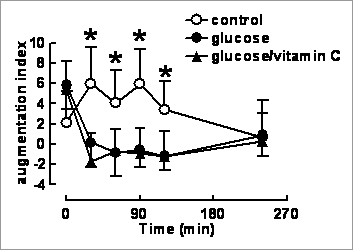Post-prandial modulation of arterial stiffness following an oral glucose load
Morbidity and mortality associated with cardiovascular disease is related to structural and functional properties of the arterial wall. Changes in these properties can lead to increases in arterial stiffness (Nurnberger et al., 2002). There is increasing evidence that the post-prandial state is associated with endothelial and vascular dysfunction (Nappo et al., 2002), possibly associated with oxidative stress. Despite overwhelming evidence linking hyperglycaemia and cardio- and diabetic vascular disease surprisingly little is known about the molecular mechanisms underlying this relationship. An understanding of the nature of glucose-mediated post-prandial vascular reactivity under, so-called, normal physiological conditions is an important first step in exploring this relationship. Here we have investigated the effect of an oral glucose load on arterial stiffness in healthy volunteers. E thical approval was obtained and 11 volunteers, with no significant cardiovascular risk and no concurrent medication, were recruited. Arterial stiffness was determined by deriving the augmentation index (AI) following analysis of the pressure wave form measured at the radial artery by applanation tonometry (Sphygmocor®, ScanMed, UK; Millasseau et al., (2003)) Subjects received, separated by a week: 300 ml water, 300 ml water + 75 g glucose and 300 ml water + 75 g glucose + 2 g vitamin C. AI was assessed over the subsequent 4 hr period and blood taken to assess total antioxidant status ( TAOS), an index of the bloods ability to deal with oxidative stress, glucose and insulin. Glucose produced a decrease in arterial stiffness (reduction in AI) within 30 min that returned to control levels at 4 hr. This is likely the result of increased insulin production acting as a vasodilator (Clerk et al., 2004). Vitamin C has no effect. Mean arterial pressure, heart rate and TAOS were unchanged throughout. Glucose peaked at 30 min (water, 4.7±0.06 mM; glucose, 7.5±0.6 mM; glucose + vitamin C, 7.8±0.5 mM), insulin peaked at 60 min (water, 5.5±0.8 mIU/ml; glucose, 67.0±10.2 mIU/ml; glucose + vitamin C, 66.7±10.8 mIU/ml). Figure 1. Augmentation index (AI) following 75g glucose (p.o.) ± vitamin C. Data are mean ± s. e. mean (* p < 0.05 for glucose or glucose + vitamin C versus control, by ANOVA).
In summary we have shown that post-prandial arterial stiffness (a surrogate marker of vascular reactivity and endothelial function) is reduced. This effect is likely an adaptive response to glucose and further experiments will show if this is blunted in vascular disease and/or diabetes since any impairment (with attendant oxidative stress) will only be manifest in individuals where periods of prolonged post-prandial glycaemia prevail.
Clerk, L. H. et al. (2004) Diabetes Metab. Res. Rev. 20, 2-12. |


